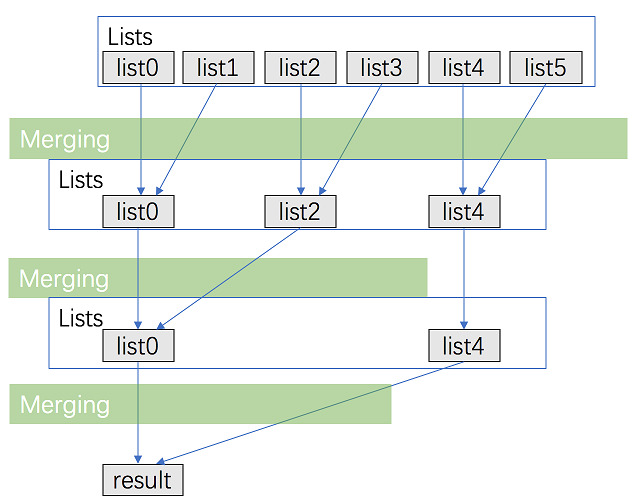All leaked interview problems are collected from Internet.
23. Merge k Sorted Lists
Merge k sorted linked lists and return it as one sorted list. Analyze and describe its complexity.
Solution
Approach #1 Brute Force [Accepted]
Intuition & Algorithm
- Traverse all the linked lists and collect the values of the nodes into an array.
- Sort and iterate over this array to get the proper value of nodes.
- Create a new sorted linked list and extend it with the new nodes.
As for sorting, you can refer here for more about sorting algorithms.
Complexity Analysis
-
Time complexity : where is the total number of nodes.
- Collecting all the values costs time.
- A stable sorting algorithm costs time.
- Iterating for creating the linked list costs time.
-
Space complexity : .
- Sorting cost space (depends on the algorithm you choose).
- Creating a new linked list costs space.
Approach #2 Compare one by one [Accepted]
Algorithm
- Compare every nodes (head of every linked list) and get the node with the smallest value.
- Extend the final sorted linked list with the selected nodes.
!?!../Documents/23_Merge_lists.json:1000,563!?!
Complexity Analysis
-
Time complexity : where is the number of linked lists.
- Almost every selection of node in final linked costs ( times comparison).
- There are nodes in the final linked list.
-
Space complexity :
- Creating a new linked list costs space.
- It's not hard to apply in-place method - connect selected nodes instead of creating new nodes to fill the new linked list.
Approach #3 Optimize Approach 2 by Priority Queue [Accepted]
Algorithm
Almost the same as the one above but optimize the comparison process by priority queue. You can refer here for more information about it.
Complexity Analysis
-
Time complexity : where is the number of linked lists.
- The comparison cost will be reduced to for every pop and insertion to priority queue. But finding the node with the smallest value just costs time.
- There are nodes in the final linked list.
-
Space complexity :
- Creating a new linked list costs space.
- The code above present applies in-place method which cost space. And the priority queue (often implemented with heaps) costs space (it's far less than in most situations).
Approach #4 Merge lists one by one [Accepted]
Algorithm
Convert merge lists problem to merge 2 lists () times. Here is the merge 2 lists problem page.
Complexity Analysis
-
Time complexity : where is the number of linked lists.
- We can merge two sorted linked list in time where is the total number of nodes in two lists.
- Sum up the merge process and we can get: .
-
Space complexity :
- We can merge two sorted linked list in space.
Approach #5 Merge with Divide And Conquer [Accepted]
Intuition & Algorithm
This approach walks alongside the one above but is improved a lot. We don't need to traverse most nodes many times repeatedly
-
Pair up lists and merge each pair.
-
After the first pairing, lists are merged into lists with average length, then , and so on.
-
Repeat this procedure until we get the final sorted linked list.
Thus, we'll traverse almost nodes per pairing and merging, and repeat this procedure about times.

Complexity Analysis
-
Time complexity : where is the number of linked lists.
- We can merge two sorted linked list in time where is the total number of nodes in two lists.
- Sum up the merge process and we can get:
-
Space complexity :
- We can merge two sorted linked lists in space.
Analysis written by: @Hermann0